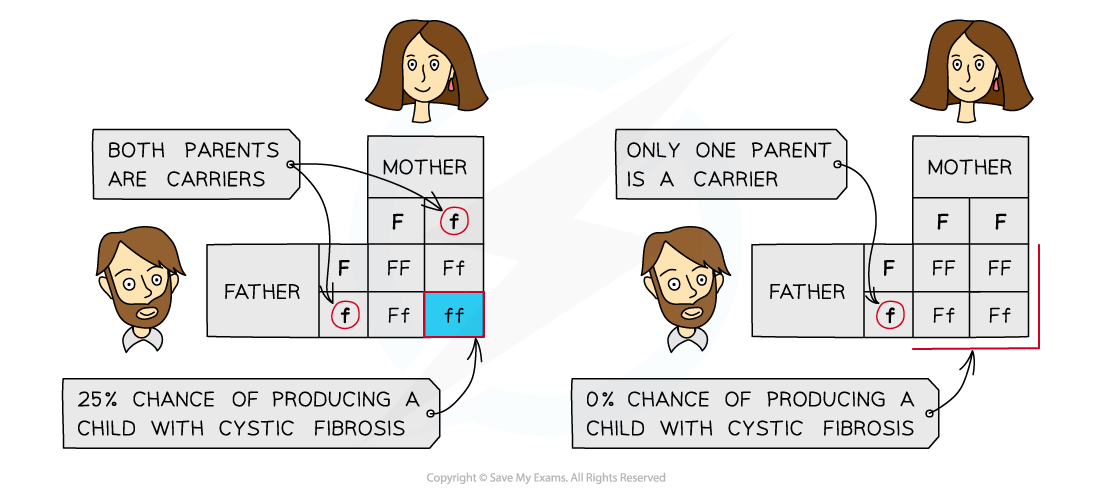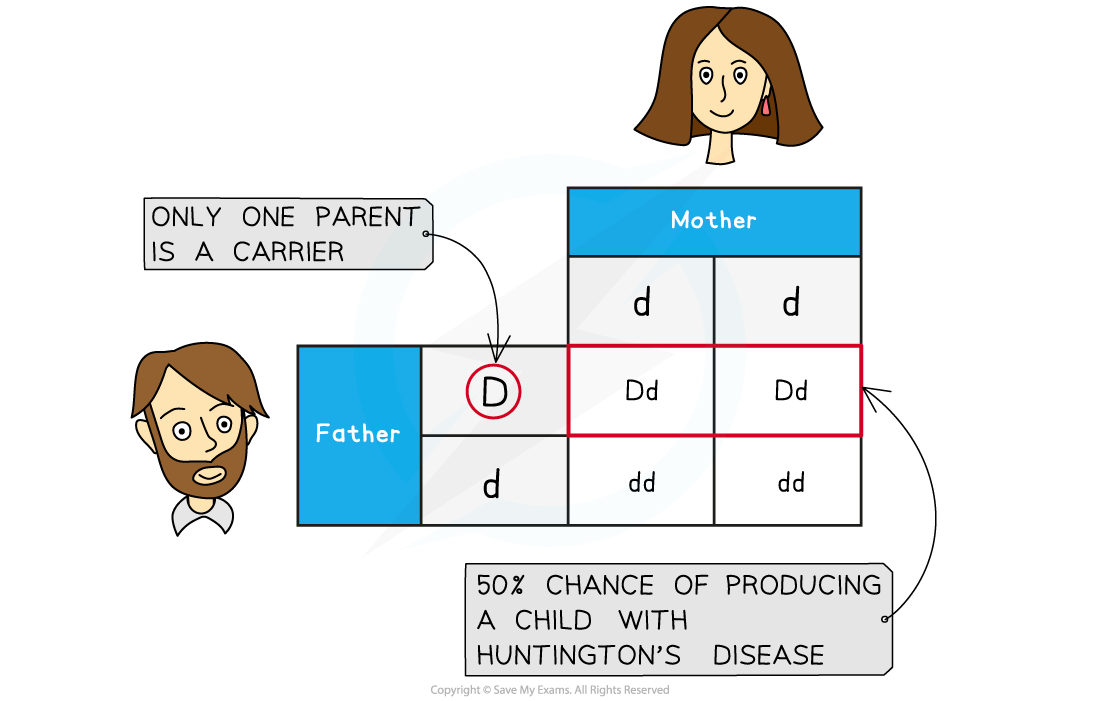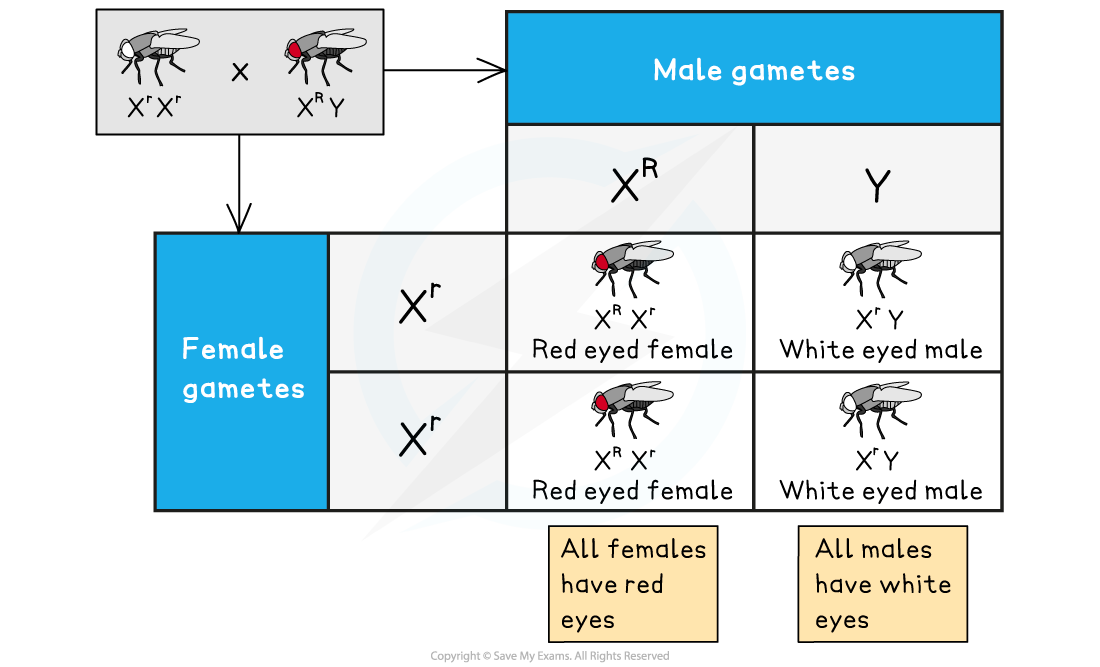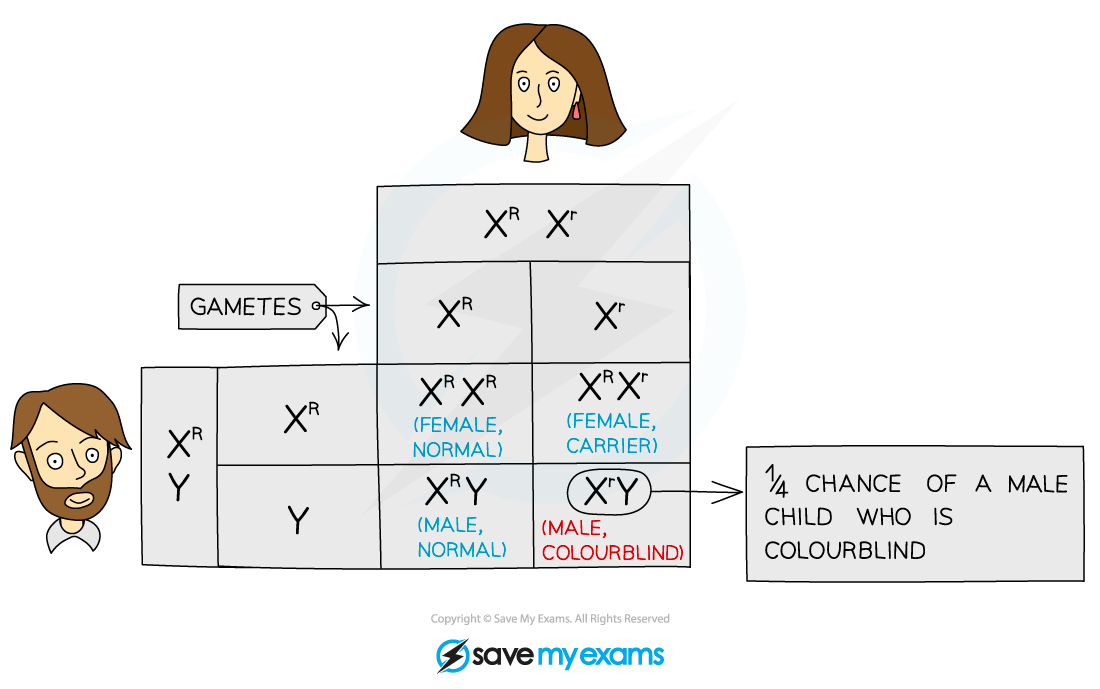Causes of Genetic Diseases
- A gene can affect the phenotype of an organism
- A gene codes for a single polypeptide
- The polypeptide affects the phenotype through a particular mechanism
- The phenotype of an individual can also be affected by the environment
- A genetic disease is caused by a gene which results in an abnormal protein that alters the phenotype of the individual
- Most genetic diseases are caused by recessive alleles on autosomal chromosomes
- This means that an individual would need two copies of the recessive allele in order to develop the disease
- Individuals that are heterozygous do not suffer from the disease but are carriers and can pass the recessive allele on to the next generation
- A disease determined by a recessive allele includes cystic fibrosis
- Some diseases are caused by dominant
- This means that only one copy of the allele is required in order to develop the disease and this one copy can also be passed on to the next generation
- Individuals that are homozygous dominant, will suffer from the disease and will also pass the allele on to the next generation with 100% probability
- A disease determined by a dominant allele includes Huntington's disease
- It is also possible, but rare, for a disease to be caused by codominant alleles
- This means that in individuals with heterozygous genotype, both alleles are expressed in the phenotype
- Therefore giving a 3rd phenotype that is different to the homozygous phenotypes
- A disease determined by codominant alleles includes sickle cell anaemia
- The genes which causes some genetic diseases are found on the sex chromosomes
- This means they affect males and females differently
- Examples of sex-linked diseases include haemophilia and colour blindness
Exam Tip
You may be asked to predict the inheritance of diseases like the ones above. An example question would be:
Max and Jane are trying for a baby but they are concerned about the possibility of their child having haemophilia. Neither Max or Jane have haemophilia themselves but Jane’s father had the condition. What are chances that their child could have haemophilia?
For questions like this, it is very important to gather early on whether the abnormal allele that causes the disease is dominant or recessive and if there is any sex linkage. In this example for haemophilia, the abnormal allele is recessive and the gene is sex-linked. Then the next step would be to work out the genotypes of the parents from the information given and use this to create a genetic diagram.
Examples of Genetic Diseases
Cystic Fibrosis
- Cystic fibrosis is a genetic disorder of cell membranes caused by a recessive allele (f) of the CFTR gene located on chromosome 7
- This gene codes for the production of chloride ion channels required for secretion of sweat, mucus and digestive juices
- A fault in the CFTR gene leads to production of non-functional channels
- This leads to reduced levels of sodium chloride in secretions which subsequently reduces the movement of water by osmosis into the secretions
- Ultimately resulting in the body producing large amounts of thick, sticky mucus in the air passages
- Over time, the mucus builds up in the lungs leading to infections and blocks narrow passage ways, such as the pancreatic duct, leading to reduced digestive efficiency as a result of less enzyme secretions
- Cystic fibrosis is determined by a recessive allele, this means:
- People who are heterozygous (only carry one copy of the recessive allele) won’t be affected by the disorder but are ‘carriers’
- People must be homozygous recessive (carry two copies of the recessive allele) in order to have the disorder
- If both parents are carriers, the chance of them producing a child with cystic fibrosis is 1 in 4, or 25%
- If only one of the parents is a carrier (with the other parent being homozygous dominant), there is no chance of producing a child with cystic fibrosis

Inheritance of cystic fibrosis if both parents are carriers or if only one parent is a carrier
Huntington's Disease
- Huntington’s disease is a genetic condition that develops as a person ages
- Usually a person with the disease will not show symptoms until they are 30 plus years old
- An individual with the condition experiences neurological degeneration; they lose their ability to walk, talk and think
- The disease is ultimately fatal
- It has been found that individuals with Huntington's disease have abnormal alleles of the HTT gene
- The HTT gene codes for the protein huntingtin which is involved in neuronal development
- The abnormal allele is dominant over the normal allele
- If an individual has one abnormal allele present they will suffer from the disease
- If only one parent is a carrier of the dominant allele, there is still a 1 in 2 or 50% chance of producing a child with the disease

Huntington’s is caused by a dominant allele
Sex-linked Genetic Diseases
- Some genetic diseases in humans are sex-linked
- Inheritance of these diseases is different in males and females
- Sex-linked genes are only present on one sex chromosome and not the other
- This means the sex of an individual affects what alleles they pass on to their offspring through their gametes
- If the gene is on the X chromosome males (XY) will only have one copy of the gene, whereas females (XX) will have two
- There are three phenotypes for females - normal, carrier and has the disease, whereas males have only two phenotypes – normal or has the disease
Sex linkage in drosophila
- Thomas Morgan discovered sex linkage in Drosophila through studying the ratios of offspring produced from crosses of flies with different eye colours
- He found that when crossing white eyed females and red eyed males, the ratios achieved were different to those observed when crossing red eyed females with white eyed males
- For example, when crossing a red eyed male, XRY, with a white eyed female, XrXr, Thomas Morgan found that all female offspring had red eyes and all male offspring had white eyes
- If this was a gene found on an autosome, he would have expected to see that all of the first filial (F1) generation would have red eyes because red is dominant
- Analysis of the results lead Thomas Morgan to deduce that the gene for eye colour was found on the X chromosome and therefore males possessed only one allele for that phenotypic characteristic

Eye colour in Drosophila is determined by a gene found on the sex chromosomes
Exam Tip
The expected notation when writing about sex linked alleles is to use upper case 'X' and 'Y' for the chromosome, next to superscript letters to represent the allele. For example XfXf or XfY.
Examples of Sex-Linked Genetic Diseases
Red-green colour blindness
- The gene which is responsible for synthesizing the photoreceptor proteins of the eye, are found on the X chromosome
- The photoreceptor proteins are made in the cone cells of the eye and detect the specific wavelengths of light entering the eye
- Red-green colour blindness is caused by a recessive allele of this gene
- Males are more likely to be red-green colour blind as they only posses 1 allele for the gene, whereas females have 2 alleles and need to inherit 1 faulty allele from both parents in order to be colour blind

Punnett grid showing the inheritance of colourblindness, an X-linked condition
Haemophilia
- Haemophilia is a well known sex-linked disease
- There is a gene found on the X chromosome that codes for a protein called factor VIII. Factor VIII is needed to make blood clot
- There are two alleles for factor VIII, the dominant F allele which codes for normal factor VIII and the recessive f allele which results in a lack of factor VIII
- When a person possesses only the recessive allele f, they don’t produce factor VIII and their blood can't clot normally
- If males have an abnormal allele they will have the condition as they have only one copy of the gene
- Females can be heterozygous for the faulty gene and not suffer from the condition but act as a carrier
- This means that haemophilia is a potentially fatal genetic disease which affects males more than females
Worked Example
Worked example: Haemophilia
- The genetic diagram below shows how two parents with normal factor VIII can have offspring with haemophilia
Parental phenotypes: carrier female x normal male
Parental genotypes: XFXf XFY
Parental gametes: XF or Xf XF or Y
Monohybrid Punnett Square with Sex-linkage Table

Predicted ratio of phenotypes in offspring
1 female with normal blood clotting : 1 carrier female : 1 male with haemophilia : 1 male with normal blood clotting
Predicted ratio of genotypes in offspring: 1 XFXF : 1 XFXf : 1 XFY : 1 XfY
Exam Tip
Make sure to include all of your working out when constructing genetic diagrams. It is not enough just to complete a punnett grid, you need to show that you have thought about the possible gametes that can be produced by each parent.Also, remember to state the phenotype as well as the genotype of the offspring that result from the cross. Read the questions carefully when answering sex-linked inheritance questions – is the question asking for a probability for all children or is it asking about a specific sex (males or females).
Human Genetic Diseases
- There are thousands of genetic diseases that affect humans, although many are caused by recessive alleles and are therefore very rare
- Naturally numbers of people suffering from diseases caused by recessive allele remains very low due to the low probability of inheriting 2 recessive alleles. This is the recognised pattern of Mendelian inheritance
- Additionally, the Human Genome Project made it possible to sequence the entire human genome and opened up the opportunity for scientists to pinpoint which part of the genome is responsible for specific genetic diseases
- Now individuals can go through tests to sequence their own genome in order to establish the likelihood of inheriting an allele which could cause a genetic disease
- Parents may choose to go through this sequencing process before having children so that they are aware of the risks
- They can make informed decisions based on the outcome of the test
